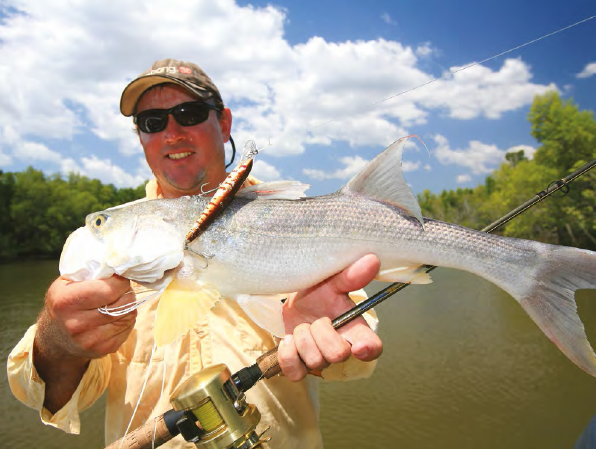
Threadfin salmon are a tropical estuary inhabitant common around much of northern Australia. A unique species with long, whisker-like fins on their chin, these shallow water predators are anything but docile and are capable of furious bursts of speed that will surprise many anglers.
A ferocious predator they patrol throughout the murky shallow flats adjacent to the mangrove stands. In Australia there are two main species of threadfin salmon – the king and the blue. Threadfin salmon are a rather odd, almost primitive-looking species that resemble no other sportfish. A thick-bodied fish, threadfin have small heads, which make them look all out of proportion.
Threadfin are really quite amazing creatures; they start their lives as males and then change into females. They can potentially grow to more than 30kg and exceed 150cm in length – at this size they would be more than 20 years old. Blue salmon are the smaller cousin maxing out at just 80cm in length.
An inshore predator, threadfin prefer shallow water and are rarely found in water deeper than 10m making them prime, land-based targets for everyone travelling north. Favouring murky waters they haunt the tidal mudflats and the lower reaches of river estuaries and like hiding around mangroves.
Being estuarine predators, threadfin – and their prey – are influenced by the tide. As the tide starts to drop threadfin patrol the drop-offs, gutters and holes ready to ambush bait forced back off the flats. The further the tide drops the more intense the action becomes.
The best tides are those with the greatest movement, which are known as the spring tides. Have a look at the tide chart for the days where there is the greatest variation between high and low tides; this occurs around the full and new moon.
The best time of year is during the dry season when there is little flow in the rivers of tropical Australia. Threadfin and other predators are often more concentrated around the lower reaches at this time, making them easier to find. Alternatively, at the lower end of their range, especially in Queensland, the summer months are the peak time.
FISHING TIPS
Threadfin are very aggressive fish and will hit lures or baits without hesitation. Generally, lures work best when the water is clearer, while baits are a better option in really murky conditions.
Lure fishing can be really exciting, especially when the fish can be seen actively feeding. A boil or swirl near a bait school is another dead giveaway and a lure landing near it will usually receive an immediate response. Better still, the presence of bait behaving nervously on the surface is a sure sign. On the flood tide threadfin can be seen cruising the shallows making for prime sight-casting targets which is about as exciting as it gets. The best types of lures are shallow or medium runners in the 6 to 15cm range, which have a wide action.
When retrieving the lure, do so with a slow, aggravated stop-start technique. Lures with a rattle are deadly and make it a lot easier for the fish to home in on the sound. Soft plastics are another good choice, especially prawn imitations which can be twitched and wiggled very slowly across the bottom. Remember, they use those feeler fins to detect prey concealed in the mud so the slower the retrieve the better.
Bait fishing is also very productive, and easy. Threadfin have a great sense of smell and will detect bait from quite a distance so it really is a matter of casting out then sitting back and waiting for the fish to come to you. Baits like pilchards and mullet fillets or prawns are excellent. A lightly-weighted half pilchard on a single 6/0 wide gape hook is perfect for threadfin. A small running sinker is all that is required to keep the bait on the bottom, making it a very simple and effective rig that can be used from the shore or boat.
Live baits are also deadly. Anglers targeting barramundi often catch threadfin while live baiting over rock bars or in gutters and creek mouths. Baits, such as herring, mullet and prawns will all work but, unfortunately, other undesirable species such as catfish can be a nuisance in some areas and will quickly deplete your bait supplies.
ON THE TABLE
Threadfin are excellent for eating with firm white flesh. Unfortunately, threadfin don’t freeze well so only keep enough fish for your immediate use. They are also quite hardy and can handle catch and release.
One word of warning, threadfin favour shallow muddy water around mangroves which is also a favourite with crocodiles so extreme care must be taken when shore-based fishing.
I shouldn’t need to remind you that no fish is worth your life – especially being munched on by a croc.
Category: Unknown
Written: Sun 01 June 2014
Printed: June, 2014
Published By: